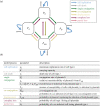Plasmid co-infection: linking biological mechanisms to ecological and evolutionary dynamics
- PMID: 34839701
- PMCID: PMC8628072
- DOI: 10.1098/rstb.2020.0478
Plasmid co-infection: linking biological mechanisms to ecological and evolutionary dynamics
Abstract
As infectious agents of bacteria and vehicles of horizontal gene transfer, plasmids play a key role in bacterial ecology and evolution. Plasmid dynamics are shaped not only by plasmid-host interactions but also by ecological interactions between plasmid variants. These interactions are complex: plasmids can co-infect the same cell and the consequences for the co-resident plasmid can be either beneficial or detrimental. Many of the biological processes that govern plasmid co-infection-from systems that exclude infection by other plasmids to interactions in the regulation of plasmid copy number-are well characterized at a mechanistic level. Modelling plays a central role in translating such mechanistic insights into predictions about plasmid dynamics and the impact of these dynamics on bacterial evolution. Theoretical work in evolutionary epidemiology has shown that formulating models of co-infection is not trivial, as some modelling choices can introduce unintended ecological assumptions. Here, we review how the biological processes that govern co-infection can be represented in a mathematical model, discuss potential modelling pitfalls, and analyse this model to provide general insights into how co-infection impacts ecological and evolutionary outcomes. In particular, we demonstrate how beneficial and detrimental effects of co-infection give rise to frequency-dependent selection on plasmid variants. This article is part of the theme issue 'The secret lives of microbial mobile genetic elements'.
Keywords: ecological and evolutionary dynamics; frequency-dependent selection; mathematical modelling; plasmid co-infection; plasmids.
Figures



Similar articles
-
Conjugative plasmid transfer is limited by prophages but can be overcome by high conjugation rates.Philos Trans R Soc Lond B Biol Sci. 2022 Jan 17;377(1842):20200470. doi: 10.1098/rstb.2020.0470. Epub 2021 Nov 29. Philos Trans R Soc Lond B Biol Sci. 2022. PMID: 34839704 Free PMC article.
-
Why do plasmids manipulate the expression of bacterial phenotypes?Philos Trans R Soc Lond B Biol Sci. 2022 Jan 17;377(1842):20200461. doi: 10.1098/rstb.2020.0461. Epub 2021 Nov 29. Philos Trans R Soc Lond B Biol Sci. 2022. PMID: 34839708 Free PMC article. Review.
-
Ecological and evolutionary solutions to the plasmid paradox.Trends Microbiol. 2022 Jun;30(6):534-543. doi: 10.1016/j.tim.2021.11.001. Epub 2021 Nov 27. Trends Microbiol. 2022. PMID: 34848115 Review.
-
Translational demand is not a major source of plasmid-associated fitness costs.Philos Trans R Soc Lond B Biol Sci. 2022 Jan 17;377(1842):20200463. doi: 10.1098/rstb.2020.0463. Epub 2021 Nov 29. Philos Trans R Soc Lond B Biol Sci. 2022. PMID: 34839712 Free PMC article.
-
The dilution effect limits plasmid horizontal transmission in multispecies bacterial communities.Microbiology (Reading). 2021 Sep;167(9):001086. doi: 10.1099/mic.0.001086. Microbiology (Reading). 2021. PMID: 34494951 Free PMC article.
Cited by
-
My host's enemy is my enemy: plasmids carrying CRISPR-Cas as a defence against phages.Proc Biol Sci. 2024 Jan 31;291(2015):20232449. doi: 10.1098/rspb.2023.2449. Epub 2024 Jan 24. Proc Biol Sci. 2024. PMID: 38262608 Free PMC article.
-
Epidemiological dynamics of bacteriocin competition and antibiotic resistance.Proc Biol Sci. 2022 Oct 12;289(1984):20221197. doi: 10.1098/rspb.2022.1197. Epub 2022 Oct 5. Proc Biol Sci. 2022. PMID: 36196547 Free PMC article.
-
One Earth: The Equilibrium between the Human and the Bacterial Worlds.Int J Mol Sci. 2023 Oct 10;24(20):15047. doi: 10.3390/ijms242015047. Int J Mol Sci. 2023. PMID: 37894729 Free PMC article. Review.
-
DNA polymerase swapping in Caudoviricetes bacteriophages.Virol J. 2024 Aug 26;21(1):200. doi: 10.1186/s12985-024-02482-z. Virol J. 2024. PMID: 39187833 Free PMC article.
-
Adaptive evolution of plasmid and chromosome contributes to the fitness of a blaNDM-bearing cointegrate plasmid in Escherichia coli.ISME J. 2024 Jan 8;18(1):wrae037. doi: 10.1093/ismejo/wrae037. ISME J. 2024. PMID: 38438143 Free PMC article.
References
-
- Rodríguez-Beltrán J, DelaFuente J, León-Sampedro R, MacLean RC, San Millán Á. 2021. Beyond horizontal gene transfer: the role of plasmids in bacterial evolution. Nat. Rev. Microbiol. 19, 347-359. - PubMed
Publication types
MeSH terms
Associated data
LinkOut - more resources
Full Text Sources
Research Materials

